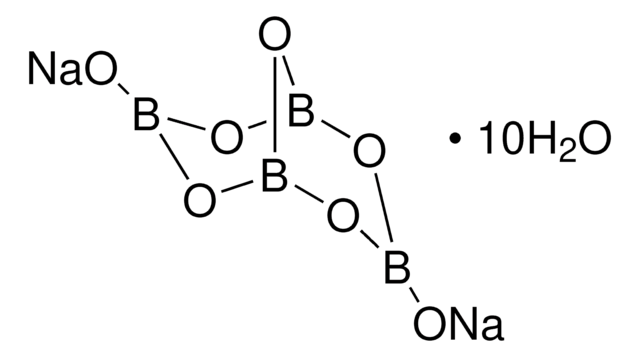B9876
Sodium tetraborate decahydrate
ReagentPlus®, ≥99.5%
Synonyme(s) :
Borax decahydrate, Sodium borate decahydrate
About This Item
Produits recommandés
Agence
suitable for SM 4500 - NH3
Niveau de qualité
Gamme de produits
ReagentPlus®
Pureté
≥99.5%
Forme
powder
pH
9.2 (10 g/L)
Densité
1.73 g/mL at 25 °C (lit.)
Température de stockage
room temp
Chaîne SMILES
O.O.O.O.O.O.O.O.O.O.[Na+].[Na+].[O-]B1Ob2ob([O-])ob(O1)o2
InChI
1S/B4O7.2Na.10H2O/c5-1-7-3-9-2(6)10-4(8-1)11-3;;;;;;;;;;;;/h;;;10*1H2/q-2;2*+1;;;;;;;;;;
Clé InChI
CDMADVZSLOHIFP-UHFFFAOYSA-N
Vous recherchez des produits similaires ? Visite Guide de comparaison des produits
Application
- A component of a buffer solution used in the separation and estimation of thiamin and its phosphate esters in commercial tablets.
- A fluxing agent in the preparation of ceramizable silicone rubber-derived composite materials.
- A crosslinking agent in the synthesis of porous foams by reacting cellulose nanofibres with poly-vinyl alcohol.
Informations légales
Mention d'avertissement
Danger
Mentions de danger
Conseils de prudence
Classification des risques
Eye Irrit. 2 - Repr. 1B
Code de la classe de stockage
6.1D - Non-combustible acute toxic Cat.3 / toxic hazardous materials or hazardous materials causing chronic effects
Classe de danger pour l'eau (WGK)
WGK 1
Point d'éclair (°F)
Not applicable
Point d'éclair (°C)
Not applicable
Certificats d'analyse (COA)
Recherchez un Certificats d'analyse (COA) en saisissant le numéro de lot du produit. Les numéros de lot figurent sur l'étiquette du produit après les mots "Lot" ou "Batch".
Déjà en possession de ce produit ?
Retrouvez la documentation relative aux produits que vous avez récemment achetés dans la Bibliothèque de documents.
Les clients ont également consulté
Notre équipe de scientifiques dispose d'une expérience dans tous les secteurs de la recherche, notamment en sciences de la vie, science des matériaux, synthèse chimique, chromatographie, analyse et dans de nombreux autres domaines..
Contacter notre Service technique









